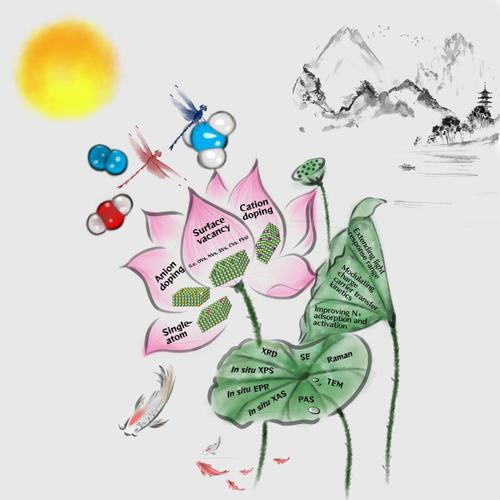Nano Research ( IF 9.9 ) Pub Date : 2021-09-04 , DOI: 10.1007/s12274-021-3725-0 Huidong Shen 1 , Mengmeng Yang 1 , Leiduan Hao 1 , Jinrui Wang 1 , Zhenyu Sun 1 , Jennifer Strunk 2

|
Engineering of defects in semiconductors provides an effective protocol for improving photocatalytic N2 conversion efficiency. This review focuses on the state-of-the-art progress in defect engineering of photocatalysts for the N2 reduction toward ammonia. The basic principles and mechanisms of thermal catalyzed and photon-induced N2 reduction are first concisely recapped, including relevant properties of the N2 molecule, reaction pathways, and NH3 quantification methods. Subsequently, defect classification, synthesis strategies, and identification techniques are compendiously summarized. Advances of in situ characterization techniques for monitoring defect state during the N2 reduction process are also described. Especially, various surface defect strategies and their critical roles in improving the N2 photoreduction performance are highlighted, including surface vacancies (i.e., anionic vacancies and cationic vacancies), heteroatom doping (i.e., metal element doping and nonmetal element doping), and atomically defined surface sites. Finally, future opportunities and challenges as well as perspectives on further development of defect-engineered photocatalysts for the nitrogen reduction to ammonia are presented. It is expected that this review can provide a profound guidance for more specialized design of defect-engineered catalysts with high activity and stability for nitrogen photochemical fixation.
中文翻译:

光催化氮还原为氨:洞察缺陷工程在光催化剂中的作用
半导体中的缺陷工程为提高光催化 N 2转化效率提供了一种有效的方案。本综述重点介绍了用于将 N 2还原为氨的光催化剂缺陷工程的最新进展。首先简要回顾热催化和光子诱导 N 2还原的基本原理和机制,包括 N 2分子的相关性质、反应途径和 NH 3量化方法。随后,对缺陷分类、合成策略和识别技术进行了简要总结。N过程中缺陷状态监测的原位表征技术进展2还原过程也进行了描述。特别强调了各种表面缺陷策略及其在提高 N 2 光还原性能方面的关键作用,包括表面空位(即阴离子空位和阳离子空位)、杂原子掺杂(即金属元素掺杂和非金属元素掺杂)和原子定义表面位点。最后,提出了未来的机遇和挑战,以及进一步开发用于将氮还原为氨的缺陷工程光催化剂的前景。预计该综述可为更专业地设计具有高活性和稳定性的氮光化学固定缺陷工程催化剂提供深刻的指导。



























 京公网安备 11010802027423号
京公网安备 11010802027423号